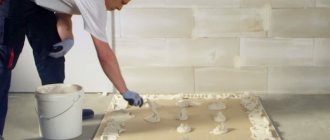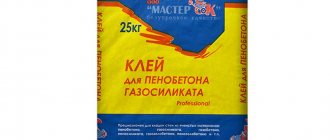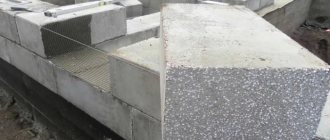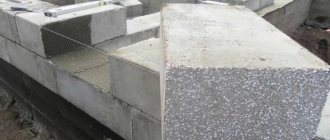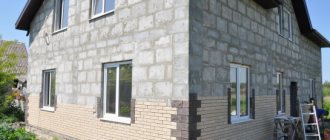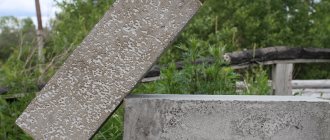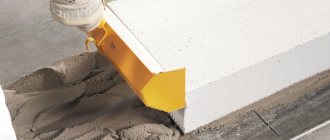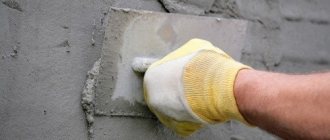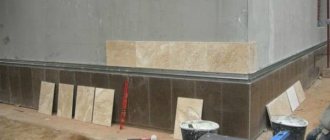Beton-House.com
Website about concrete: construction, characteristics, design. We combine the experience of professionals and private craftsmen in one place
Laying a polystyrene concrete block with glue
Polystyrene concrete block is a representative of lightweight concrete, which has a special set of properties that distinguish the material from the rest. That is why its application has its own characteristics. In particular, this applies to block laying.
In this article we will understand what material should be chosen when carrying out work, and we will pay special attention to the adhesive composition. Let's consider what is remarkable about adhesive for polystyrene concrete blocks, how to choose it correctly, and why experts advise using it as opposed to cement mortar.
- Review of the most popular brands
- List of required tools
Mode of application
Required Tools
To prepare the solution you will need:
- a container in which you will need to stir the dry bulk mixture with water;
- a drill with a special attachment (to obtain the correct consistency of sour cream, use a construction mixer);
- measuring device to maintain correct proportions.
To apply glue and carry out masonry, use a steel or notched trowel or a trowel-bucket (carriage) for aerated concrete.
Cooking method
Dry mixtures are sold in 25 kg bags. To prepare the adhesive composition, the calculation is as follows: one factory package requires five to five and a half liters of clean water (that is, 200-220 milligrams are taken per 1 kg). The liquid should be warm (from 15-18 to 60 °C).
After kneading, you should get a mass without lumps. It needs to be allowed to “settle” for five to ten minutes, and then stirred again. The glue is usable for only a couple of hours, so it is prepared in portions.
Application method
Apply aerated concrete adhesive in a minimal layer to clean blocks (without dust, dirt, or oil stains). The thickness of the joints during laying should not exceed 2-4 millimeters. The excess is removed immediately or cut off with a trowel after hardening. The position of the blocks can be adjusted within about ten minutes (perhaps with a rubber hammer). Level the surface by lightly tapping
Peculiarities
Glue is a chemical composition that ensures adhesion between different materials. If previously walls were built primarily from bricks and its analogues, today conventional construction methods are recognized as overly labor-intensive, including due to the high cost of the material.
Lightweight building blocks have become the predominant material today, significantly displacing traditional brick. Having small dimensions and easy to use, they are connected using adhesive mixtures. For block structures, specialists are developing numerous adhesives and foams for joining during the construction of building walls.
The obvious fact is that the quality of the individual components completely determines all the performance characteristics of the adhesive composition. As a rule, various brands of cement, sand, organic and other plasticizers are used in its production. The composition of the mounting adhesive depends on which blocks need to be connected to each other.
The most common cement-sand composition in the production process cannot be prepared on its own; special technologies are used for mixing. Therefore, the mixture is produced in bags weighing up to 20-25 kg.
Pros and cons of the material
Construction industry experts assure that expanded polystyrene concrete has many more advantages than disadvantages. The main advantages of lightweight material are:
- Eco-safety. The products do not contain toxic or chemical additives.
- Durability. If the production technology of polystyrene concrete meets the standards, and the operating conditions are met, a structure built from such blocks will last 70-100 years.
- Fire resistance. The building material can withstand high temperatures for a long time.
- High thermal insulation coefficient. In a room built from polystyrene concrete, a comfortable temperature is maintained even in cold winter, while energy costs are significantly reduced.
- Noise insulation.
- Easy to process, quick and easy to install masonry.
There is only one significant drawback of this universal building material - a decrease in the strength characteristics of the blocks after 20-23 cycles of freezing and thawing. If the surface constructed from polystyrene concrete block elements is not additionally treated with protective materials, cracks will gradually begin to form on the walls, and the masonry itself will collapse.
What will you need for work?
When carrying out the work, you will need equipment for the production of polystyrene concrete blocks. Experts use a concrete mixer for mixing. At the same time, you can do without equipment and use a simple mixer, the cost of which is quite reasonable. In addition, to prepare the solution you need a shovel. Before mixing the ingredients, you need to determine the required density of the concrete solution. You also need to carefully weigh all the components.
It is important to remember that different polystyrene concrete mixtures have different densities. The solution requires water, cement of the required grade, PVG, and additives
Nuances of technology
The manufacturing technology of polystyrene concrete is based on mixing two main components: cement and polystyrene. But these materials, when mixed, and even more so when the solution placed in the molds for the production of blocks is vibrated, begin to separate. Polymer granules simply float to the surface of the concrete mass, which leads to a deterioration in its technical characteristics.
Increasing the amount of added water (to increase the adhesion of the granules) did not lead to anything. The solution lost its strength characteristics, its blocks cracked severely due to large shrinkage.
Therefore, the developers of the solution have been looking for additives for a long time that could hold the granules inside the cement paste. The most effective were substances that included air-entraining components. It turned out that air bubbles up to 0.3 mm in size filled the volume of the mixture, increasing it and reducing the differences in density between the cement mortar and polystyrene granules. That is why the material became plastic.
Today, protein foaming additives are most often used in the production technology of polystyrene blocks. Because they create a stable foam, which is characterized by high mobility and adhesion to any materials. Both characteristics increase the workability of polystyrene concrete. And this is regardless of the ratio of water and cement in the solution.
But even these additives cannot counteract the shrinkage of the solution. To reduce this process, it is necessary to keep the filler moist. This is the first option to avoid cracks in the blocks. The second is to use strong fibers as a reinforcing frame inside the concrete. The latter take on the stresses inside the dough associated with shrinkage processes. At the same time, the fibers increase bending and tensile strength.
As for the equipment for the production of polystyrene concrete, a mixing plant is installed in the technological chain. It is in this that all the ingredients of the solution are mixed together.
Composition and optimal proportions for independent production
The production of polystyrene concrete is no different from the standard technology for preparing concrete solutions. That is, this is mixing components in different proportions with different addition sequences. In this case, a concrete mixer is used. It is not recommended to mix the components of the material with shovels. These tools make it impossible to evenly distribute the ingredients among themselves.
How much and what is needed per 1 m³
Depending on the goals of the work manufacturer, concrete can be produced in different grades. The proportions of polystyrene concrete depend on this. They are shown in the table below.
| Density of concrete, kg/m³ | Amount of cement M400, kg | Amount of polystyrene, m³ | Amount of water, l | Number of SDO, kg |
| 200 | 160 | 1 | 100 | 0,8 |
| 300 | 240 | 1 | 120 | 0,65 |
| 400 | 330 | 1 | 150 | 0,6 |
| 500 | 410 | 1 | 170 | 0,45 |
These four materials mixed together determine the final solution. But besides them, you can add other components to the composition that improve the properties. This can be fiber, sand or special additives. The latter increase frost resistance, plasticity and other properties.
Shampoos and household detergents cannot be used in the composition of polystyrene concrete instead of SDO. They reduce the strength of the solution.
Materials for production
The preparation of polystyrene concrete involves the use of a cement mixture and granulated polystyrene (it can be replaced with polystyrene foam). Such raw materials are characterized by high thermal insulation properties, which contribute to reliable protection of the building from freezing. Frost resistance indicators depend on the density of the concrete mixture and the main additives.
The list of necessary components for production looks like this:
- Cement mixture grade M400. If you use a higher grade composition, the solution must be diluted with sand in a 2:1 ratio.
- Expanded polystyrene. The component is sold in construction hypermarkets.
- SDO is a special additive that adds air to the mixture and promotes the appearance of air bubbles, which increase thermal insulation.
- Plasticizers. The concentration of these additives in the composition is determined by the characteristics of the mixture.
Feasibility of buildings
Thanks to positive technical characteristics, which are primarily characterized by sufficient density, strength and durability, but light weight and high-speed installation.
you can build any buildings
- private and apartment buildings;
- garages;
- baths;
- dachas;
- utility rooms;
- basements and cellars, etc.
With polystyrene concrete products they equip:
- all types of load-bearing (external) walls;
- partitions between rooms;
- ceilings in the attic;
- base surfaces;
- any combined coatings;
- ends of reinforced concrete floors;
- ceilings in basements.
High thermal conductivity properties allow the material to be used as a double insulating layer for:
- walls;
- ceilings;
- houses.
The feasibility of buildings with polystyrene concrete is due to the high performance qualities of the material, wide variability of use, lack of spontaneous combustion, reduction of the overall distributing load on the foundation, as well as the total weight of the roofing structure.
Presented as a variety of products, polystyrene concrete floor slabs help not only during primary construction, but also during the repair and reconstruction of residential buildings, where it is necessary to minimize the load on the foundation.
Bitumen adhesive Bitumast
Bitumast mastic is similar in properties to a plaster-adhesive mixture, but includes bitumen, which plays a binding role. The advantage of the glue is its excellent compatibility with extruded polystyrene foam; it adheres to the material for a long time without any complaints. The product also has waterproofing properties and protects the joints of external walls from moisture.
You can easily mix Bitumast, it takes a couple of minutes, you don’t need any special tools (you don’t even need a mixer). There is also no need to warm up Bitumast before use. The consistency is liquid, so apply in a thin layer. There is a significant disadvantage - the mastic sets slowly, and you will have to keep the EPP sheets from slipping for a long time.
Tips for choosing
The composition of the mixture for laying foam concrete is approximately similar. The difference is in the percentage of fillers and polymer additives. Therefore, when choosing, you need to familiarize yourself with the composition and manufacturer. If you carry out work in the winter season, it is better to give preference to frost-resistant glue. In the case of construction in the warm season, there is no point in overpaying. If you want to purchase an imported composition, then read the application and preparation features to make sure whether it is suitable for our conditions.
If you are unsure of your choice, it is better to turn to professionals who understand adhesives for foam concrete. You need to follow several rules:
- do not take the cheapest product;
- give preference to adhesives from trusted manufacturers;
- take into account construction time;
- After all the calculations, take one bag in reserve.
Benefits of use
Due to the thinner layer of 2-3 mm, the glue consumption is small.
It is important to know that the adhesive base for blocks has many advantages compared to cement mortar. It has already been proven that foam blocks last much longer with glue.
It is more durable and hardens quickly, which helps reduce the time for construction work. On seams made with glue, mold, cracks and crevices, which can appear on cement masonry due to sudden temperature changes, do not form.
Adhesives for laying foam blocks have the main property of vapor permeability
Thanks to this, the walls “breathe”, creating a favorable microclimate inside the room. Another important advantage is savings. Despite the fact that a kilogram is more expensive than a regular solution, the consumption is half as much
Therefore, placing foam blocks on an adhesive solution is not only correct, but also profitable.
Types of blocks used
The choice of cellular concrete as the main building material is due to a reduction in the labor intensity of installation work and a significant reduction in construction costs. The consumption of assembly adhesive for blocks is several times less than the cost of cement-sand mortar for bricklaying. Manufacturers produce several types of building blocks made of cellular concrete that can be installed with glue:
- Expanded clay concrete. A characteristic feature is a combination of high strength and low specific gravity. The composition of the building material includes small expanded clay granules (fraction 5-10 mm). The operational service life of the products is 75 years. Area of use: construction of houses, cottages, outbuildings. There are solid, hollow, structural and thermal insulating blocks made of expanded clay concrete.
- Cement-sand (concrete). They are used in low-rise construction much less frequently, since concrete products without fillers have poor thermal insulation characteristics. The blocks do not contain cells or pores, so the material is heavier and places significant loads on the foundation. Outbuildings are built from concrete blocks, since the material has good strength and frost resistance.
- Gas silicate. The walls of houses made of gas silicate blocks retain heat well and provide an optimal indoor microclimate. A prerequisite for construction is the use of high-quality glue during installation and the installation of external cladding, which protects the structure from atmospheric moisture and has vapor-tight properties. Porous blocks are characterized by low thermal conductivity, optimal dimensions and low weight.
- Polystyrene concrete. Blocks containing polystyrene are characterized by high frost resistance and sound insulation properties. The use of adhesive for polystyrene concrete blocks allows the construction of durable monolithic structures in private and industrial construction. The material contains polystyrene granules with a fraction of up to 20 mm and white quartz sand, which give the products frost resistance.
- Foam blocks. Cellular concrete with finely dispersed aggregate is inferior in strength to aerated concrete, the production technology of which is significantly different. Foam blocks have a low cost, their strength is sufficient for the construction of 2-3-story buildings. It is difficult to work with foam blocks due to the violation of the geometry of the material. To obtain more durable structures, it is better to use tongue-and-groove blocks.
Block-type building materials also include other products. Concrete with wood filler (arbolite) has the best vapor permeability and high seismic resistance. Wood concrete is a non-flammable, soundproof and environmentally friendly material. Similar characteristics are characteristic of sawdust concrete, in which sawdust rather than wood chips act as a filler.
Interesting! To build houses with beautiful facades, you can use ceramic hollow blocks of attractive shapes. Combined type blocks with heat-insulating layers and a textured layer (multi-layer “pie” with insulation) are gradually gaining popularity - heat block, heat wall, porotherm, polyblock.
Features of polystyrene concrete
Polystyrene concrete blocks are used for the rapid construction of buildings. They are also suitable for lintels in doors or windows. To seal the structure, reinforcement is included in the composition. Do-it-yourself polystyrene concrete blocks at home do not rot or be damaged by rodents. Wood cannot boast of this advantage.
The mixture is used for flooring even on open ground. In this case, there is no need to involve many people and special equipment in the process. This allows you to save significantly. Load-bearing walls and lintels must be sealed with reinforced mesh. When pouring floors, a number of preparatory works are also carried out on the ground. Forming a cushion of gravel and sand is considered optimal. Work can be carried out throughout the entire territory at once. It is also possible to divide it into separate pieces.
Expanded polystyrene concrete blocks are characterized by the following advantages:
- Do not harm the environment.
- They will last a long time if you follow the requirements during the installation process.
- The material does not suffer from prolonged exposure to high temperatures or open fire.
- Hydrophobicity.
- Provides the necessary level of heat insulation indoors.
- Homemade polystyrene concrete has low thermal conductivity. According to this property, a wall made of a standard size block corresponds to 50 cm of brick.
- Isolation of external sounds.
The material cannot be damaged by intense mechanical stress. At the same time, it can be easily sawed or drilled. It is also possible to mill and fasten individual sections with nails.
The composition of the mixture is universal. It meets high construction requirements. However, there are also disadvantages. It can withstand no more than twenty cycles of severe frosts. Over time, the blocks begin to crack. Against this background, gradual destruction is observed.
When choosing a material, you should also take into account its disadvantages:
- Low density significantly reduces the strength of the product. The resulting wall may not hold hardware well. To secure windows and doorways, you will need to additionally use 10 cm anchors.
- The heat conductivity coefficient is below standard. This leads to the need to use insulating material. The disadvantage is common to all brands.
- Low steam permeability. It is difficult to maintain optimal indoor climate conditions. Correct organization of the ventilation system will help correct the situation. Against this background, heating costs increase.
- Low strength and high hygroscopicity. If the necessary protection is not organized over the structure, the walls will begin to collapse. A double layer of plaster will improve the performance.
- The material does not meet all fire safety requirements. The combustion process produces acrid smoke. These characteristics are taken into account before starting the design of any structure. Additionally, you will need to treat the surface with special means to protect against fire. Against this background, the total cost of construction increases.
Foam plastic as a basis for adhesives
A strong adhesive is made from polystyrene foam or expanded polystyrene to hold surfaces together. This composition can also be used as a paint or protective varnish. Based on small, light balls, the adhesive solution is strong and reliable.
Foam material produces a powerful fixing mixture Source i1.wp.com
Polystyrene foam adhesive
This solution has good adhesive properties and is used in the following cases:
- for sealing cracks and joints in the roof;
- for gluing interior items;
- for decoration of household products;
- for fixing ceiling plinths;
- for joining individual pieces of polystyrene foam.
Styrofoam glue becomes a lifesaver when there is no construction adhesive nearby. Experts make it themselves. They take a solvent such as xylene, acetone or gasoline. Gasoline dissolves foam perfectly, so it is considered the optimal component for glue. Then take pieces of polystyrene foam or expanded polystyrene: the larger they are, the more viscous the finished solution is. Polystyrene foam is gradually placed in a jar of solvent and the workpiece is stirred. As soon as the glue is ready, it is immediately used for its intended purpose.
The solvent instantly corrodes the foam Source mauro-gianvanni.ru
This composition is not stored for a long time, so it must be used immediately. Glue is applied to the surface and the desired material is glued. Experts make sure that there are no smudges on the product: ingrained composition is very difficult to wipe off after it dries.
Manufacturers
A wide range of adhesive compositions for laying foam blocks often confuses finishers. How to choose the right composition? How not to make a mistake when purchasing a mixture? What should foam blocks be mounted on?
To get started, remember a few simple rules:
the stingy pays twice - do not try to chase the cheapness, purchase a product from a well-known manufacturer that has a good reputation in the building mixtures market when making a purchasing decision, take into account the time of year and temperature conditions under which the work will be carried out - for the winter it is advisable to purchase a frost-resistant composition
And now let’s get acquainted with the creators of the most popular adhesive compositions, which have earned positive reviews from professionals around the world.
Volma
Volma is one of the leaders in the construction market, having won recognition from consumers in Russia and abroad. The adhesive of this brand consists of selected cement, fine-grained sand, filler and pigments of the most exceptional quality. This composition is used for seams of 2-5 mm.
Finishers use this glue when installing slabs from cellular concrete blocks.
Sold in paper bags of 25 kg.
Titanium
When adhesive foam from the famous Titan brand first appeared on the market, most professionals were skeptical about this new product. However, after the first applications, doubts about the quality and exceptional consumer performance of the composition completely disappeared.
Titan products replace cement mortars and are very easy to use - you just need to apply a strip of the composition to the blocks and fix them. Construction is progressing quite quickly, and the finished structure is durable and stable.
When using foam adhesive, you should adhere to several rules:
- the surface of the foam blocks should only be flat;
- the adhesive layer is applied in accordance with the instructions, do not exceed the thickness recommended by the manufacturer;
- the foam shrinks under the influence of direct ultraviolet rays, so the outside joints should be sealed with cement;
- Adhesive foam is used only for the second layer of foam blocks. The first must be applied to a cement-sand mortar, otherwise the glue will quickly deform under the heavy weight.
Sold in 750 ml cylinders.
Knauf
Knauf Perlfix adhesive provides a high level of adhesion thanks to a gypsum base and special polymer additives.
The use of glue does not require preliminary installation of the frame, the work is carried out quickly, and the structure is stable.
The undoubted advantage of the composition is its environmental safety, which is why it is widely used in private housing construction.
The glue is used quite economically - for processing a coating of 1 sq. m. only 5 kg of composition will be required.
Sold in kraft bags, packaged 30 kg.
IVSIL Block/IVSIL Block
The glue from this manufacturer is widely used when laying foam concrete and gas blocks. The mixture is a dry powder composition based on cement with a small content of additives that increase surface adhesion.
Used for seams from 2 mm, with this glue consumption will be within 3 kg per m2.
When using glue, you can adjust the position of the foam blocks within 15 minutes from the moment of fixation.
Sold in bags of 25 kg.
Founds Selform T112
This is a frost-resistant composition intended for use in winter. The formed seams can easily withstand up to 75 freezing and thawing cycles - this figure is one of the highest among winter types of adhesive for foam concrete.
The adhesive mixture is characterized by a fine filler fraction, due to which it is used to produce thin seams from 1 mm. This leads to a reduction in the overall consumption of the composition - to paste 1 m2 of foam blocks you will need only 1.6 kg of dry glue.
The advantage of the glue is its fast setting - the composition hardens within 2 hours, so construction work can be carried out quite quickly.
Sold in bags of 20 kg.
Among Russian manufacturers, the Rusean brand is also distinguished as having high quality and cost-effective products.
How to calculate how much glue you will need
The cost of adhesive mortar when laying light blocks of cellular concrete is influenced by the type of material and installation features. Highly porous products require more glue. It is necessary to take into account moisture absorption and the thickness of the seam being formed. The following factors influence glue consumption:
- Masonry conditions: dry, windless weather, negative temperatures, high humidity, heat.
- The presence of deformed areas on the surface of the blocks - more ready-made mixture is required to fill cracks and chips.
- The type of block material is lightweight cellular concrete with a large number of pores or dense autoclaved silicate.
- The thickness of the formed layer depends on the geometry of the blocks; the recommended value is indicated by the manufacturer on the packaging.
- The area of the processed surface - the dimensions of block building materials are not the same.
- Geometry of building materials - if the blocks are uneven, more glue is needed for perfect masonry.
If we compare the installation of masonry using classic cement-sand mortar or special glue, in the second case the costs of the finished mixture and the labor intensity of the work are significantly reduced. The use of adhesives allows you to make thin interblock seams up to 5 mm, which have very high strength and maximum adhesion to the surface.
According to construction standards, the adhesive consumption for gas and foam concrete is on average 1.5-1.6 kg of dry mixture per 1 m3 when applying a 1 mm thick seam. Minimum consumption is possible if the blocks are perfectly flat and the laying technology is followed.
Tip: To form thin seams and prevent the formation of cold bridges in the masonry, it is better to use adhesives with fine-grained filler. The result is thin, smooth seams of optimal strength, not susceptible to the formation of dampness and fungus.
Tips for saving glue
Dimensions of the standard block – 200x300x600 mm. Based on these parameters, manufacturers set the recommended rate of glue consumption for the construction of block structures. In order to carry out the laying correctly and spend less glue, the master should adhere to some rules:
- The product must be applied in compliance with the temperature regime.
- For winter work, special frost-resistant glue is used.
- Mix dry powder with water according to the manufacturer's instructions.
- The solution is mixed in measured portions so that it does not dry out.
- The glue is applied in a thin layer, following standard rules.
The mixture is applied to the surface of the block with a notched trowel, which saves 20-30%. To prevent moisture from evaporating from the solution very quickly, it should be prepared in a warm room and then delivered to the construction site. To obtain a homogeneous adhesive mixture, the solution is constantly stirred.
Block structures are replacing brick buildings because they require less time and money to build. The use of adhesives simplifies the installation process and allows you to build strong walls that are well protected from atmospheric and mechanical influences. The quality of the masonry depends on the properties and characteristics of the glue, so the choice of product must be approached responsibly.
Laying aerated concrete blocks with glue (2 videos)
Types of adhesives for blocks (22 photos)
What is adhesive foam for aerated concrete?
In order for a house made of aerated concrete blocks to be reliable and warm, during its construction it is important to prevent the appearance of cold bridges in the walls. If you use ordinary cement mortars for masonry, the thermal conductivity coefficient of which is much higher than that of the blocks themselves, then the thermal insulation capabilities of the material are lost by almost a third
Therefore, the seams between the blocks should be as thin as possible, which is achieved through the use of adhesive compositions with certain properties.
Seams in aerated concrete walls
Stores sell dry mortars for aerated concrete blocks with fine-grained filler, excellent ductility, high adhesion and durability. With their use, heat losses are sharply reduced, and the layer thickness is only a few millimeters.
But now a new adhesive has appeared on the market in the form of polyurethane-based foam, which allows you to make interblock seams even thinner without losing strength. This material has excellent thermal insulation qualities, is applied using a gun and is a polyurethane that foams after leaving the cylinder.
Technical features of adhesive foam
The foam composition has high technical and operational parameters, therefore it ensures optimal quality of construction. Main characteristics of adhesive foam:
- period of complete hardening - 2 hours;
- time to adjust blocks – 3 minutes;
- moisture resistance – no less than 95%;
- operating temperature – from -60 to +100 degrees (depending on the specific brand and type of glue);
- resistance to mold;
- excellent sound and heat insulation properties.
Composition and scope of application
Adhesive foam for aerated concrete blocks consists of polyurethane - a modern synthetic polymer whose properties are superior to rubber, caoutchouc and many types of plastics. Also, targeted additives are introduced into the composition (hardening accelerators, modifiers, antiseptics, fungicides, antifreeze, etc.).
Polyurethane adhesive foam
The main purpose of the material is reduced to the laying of aerated concrete blocks and slabs, including the construction of load-bearing walls and partitions. Adhesive foam is also suitable for working with ceramic blocks on vertical and horizontal planes and for cellular concrete.
Important! It can be used to attach thermal insulation materials to walls before finishing
Varieties
There are two types of composition on sale, which differ in properties and color:
- White glue. It is considered “summer”, since it can only be used in the warm season. The material perfectly matches the shade of autoclaved aerated concrete blocks, so when using it you can partially save on interior decoration (it will not stand out much from the main masonry).
- Gray glue. Suitable for the cold season and also as an all-season product. The adhesive contains anti-freeze components, so it can withstand many cycles of freezing and thawing. The adhesive can be applied even at temperatures down to -10 degrees, so it is possible to lay blocks in winter.
Release form
The composition is sold in the form of aerosol cans of 750-1000 ml, which greatly simplifies its application to the base. The cylinders are suitable for use in conventional spray foam guns.
How long does it take to set and gain strength?
The setting time and strength gain depends on the brand of glue. Average indicators for classic solutions :
- The setting time of the solution after applying it to the surface is about 20 minutes.
- The seam hardens within 24-30 hours.
- Complete hardening after installation is observed after 3 days.
High-quality glue should not set faster than 15 minutes and slower than 20 minutes.
Seasonal varieties
Universal gray glue is used not only in winter, but also in summer.
Nowadays two types of mixtures are used for the construction of buildings. Adhesive for aerated concrete blocks is:
- White. It is considered summer, used in warm seasons. It owes its light shade (the same as that of autoclaved aerated concrete) to white Portland cement, which makes it possible to save on interior decoration.
- Gray. Although this type is called winter, it is universal and suitable for work in any season. Due to the presence of antifreeze additives in the composition, it is recommended for use in cold weather, however, it also has a certain temperature limit.
DIY polystyrene concrete blocks
Nowadays, many builders refuse to use traditional building materials, preferring new products created using modern technologies. This is not surprising, because thanks to new developments it is possible to build houses and other structures that are strong and durable. Moreover, the cost of such materials is often more affordable than the cost of traditional means. In particular, polystyrene concrete and expanded polystyrene concrete have become very popular today. Blocks from this material can be made at home. The production of polystyrene concrete blocks will save money on building materials.
Polystyrene concrete is one of the types of lightweight concrete mortars, which are presented in the form of a composite building material. The ingredients used in the preparation are granulated and polystyrene Portland cement.
Preparation of adhesive solution
The dry mixture is poured into a container with clean water at room temperature; in winter, the readings should not reach more than +30 degrees C. Afterwards, everything is thoroughly mixed until a homogeneous mass is formed. Next, you need to let the glue sit for a while - 10-15 minutes. Then mix everything again. The finished mixture should be applied with a notched trowel. Construction work is carried out at temperatures not lower than + 5. At low temperatures, it is recommended to use anti-frost additives.
The adhesive for polystyrene concrete blocks has the following consumption rates according to the manufacturers - the layer thickness is 1 mm, in order to lay one cubic meter of blocks you will need one package of dry mixture of 25 kg. This is acceptable in theory, but in practice it is impossible to make such a thickness. The amount of glue required depends on the following factors:
- consumption directly depends on the skill of the masons. When an experienced specialist works, significantly less material will be used;
- weather conditions have an impact on material consumption;
- Depending on the product brand and manufacturer, the thickness of the layer may vary due to some characteristics of the adhesive mixture itself.
Laying blocks with glue
How to glue polystyrene foam to concrete during the process of insulating a structure. This is done using the following adhesive mixtures:
- latex bitumen emulsion mastic;
- silicone based glue;
- specialized polyurethane foam;
- dry construction mixture consisting of cement, polymer additives and plasticizers.
The progress of the work is simple. The adhesive should be applied over the entire surface of the polystyrene foam board using a notched trowel. Then the blocks are pressed against the wall surface.
When the finished mixture is applied to the block, it is worth stepping back from the edge by about 2 centimeters. This will be necessary so that the excess glue, when pressed, has somewhere to protrude and be evenly distributed. If the wall surface is smooth, it is better to use a notched trowel. Afterwards the slab should be pressed against the wall.
How to glue extruded polystyrene foam to concrete? It is known that such material has excellent qualities - high strength, water resistance, durability. The following adhesive mixtures are used during construction work:
- bitumen mastic base, which includes unified bitumen, plasticizers and solvent. With the continuous application method, it will serve as a good waterproofing agent. The mastic is also resistant to freezing;
- polyurethane foam, which is applied using a mounting gun. The mixture can be used at low temperatures down to -10 degrees C. One bottle can replace 1 25 kg bag of glue.
Mixture requirements
For this type of wall material, the masonry composition will need to meet the following requirements:
- High plasticity, so that all roughness, cracks and empty spaces in the blocks are efficiently filled.
- Sufficient strength after thickening is complete so that the solution does not cause deformation of the gas-block walls.
- Have the required period of time for setting so that the master has time to work it out before it hardens. Typically, in the presence of plasticizers and additives, such properties are maintained for 1.5-2.5 hours.
- relatively low cost for all components of the composition;
- availability of all components;
- good ductility, ability to accept the established configuration;
- high levels of rigidity;
- does not exhibit arbitrary shrinkage.
At the same time, many novice craftsmen experience difficulties in following the technology for making the mixture and the required proportion, which can lead to the creation of low-quality masonry.
Consumption per 1m2
Calculation of consumption per sq. m. is needed to determine the required amount of material to purchase. It is impossible to calculate the exact amount. This is influenced by factors:
- material, its density and ability to absorb;
- consumption of a specific type and brand of mixture.
The average data is shown in the table.
| Type of composition | Consumption |
| Dry | 500 gr. / m² |
| Bituminous | 800-1000 gr. / m² |
| Polyurethane | 1 cylinder per 8-10 m² |
Seamless masonry technology
Polyurethane foam used during installation must be pre-prepared. To do this, it is left for up to 24 hours in a room with a temperature of at least 20 °C. After this, the foam containers must be shaken vigorously. It is also advisable to repeat this action during work. Installation with adhesive foam is carried out using a glue gun in compliance with standard working conditions.
Laying the starting row
When using adhesive foam instead of a classic cement-sand mortar, the technology for laying the starting row has no fundamental differences.
The first row is erected on an isolated foundation, which is installed on a corrective layer of cement-sand mortar grade 100 with a maximum thickness of up to 20 mm or up to 40 mm, but reinforced with a masonry mesh to ensure high flatness of the surface of the row.
The corner blocks are installed first, the position of which is determined by a range finder, and the height - by a level or laser axle maker. The maximum tolerance is 3 mm for every 10 m of row length.
Under the corner elements, after the correction layer has completely set, the mooring cord is pulled, after which the linear sections are filled. In this case, additional elements should not have a length of less than 50 mm and should be placed either directly on the corners, or 3-4 blocks from the corner one.
The dimensions of the starting row extensions, which determine the entire dressing scheme as a whole, should provide, depending on the characteristics of the soil on which the construction is carried out, a displacement of at least:
- 1/5 of the block height – on incompressible soil;
- 1/2 of the height - on MZLF with support on weakened soil.
It takes at least 10 hours for the starting row to fully set.
Walling
Aerated concrete blocks are laid strictly sequentially in rows, corner peaks are not displayed. The blocks of each laid row must be thoroughly wiped down until possible height differences are completely minimized. To lay the reinforcement, a groove is cut, which is necessary due to the increased creep of the masonry.
The reinforcement bars are tied into a single contour and placed in a groove filled with an adhesive composition with a mineral base. After wiping off the excess, it is necessary to remove dust from the surface, corner stones are laid, observing the alternation of pokes and spoons in adjacent rows.
Foam is applied to the gas block at the rate of one strip (no more than 2-3 cm wide) per 10 centimeters of surface area. Thus, two strips of foam are applied to a 20 cm wide block, and three to a 30 cm wide block. With a greater thickness, the adhesive foam is distributed in a zigzag manner. Also, the foam must be applied to the poke of the adjacent stone, after which there is about a minute to install and prepare the next gas block. In this case, the adhesive foam finally sets after 20 minutes, which must be taken into account for timely correction of defects in the work.
Requirements for gas block geometry
When laying cellular concrete on foam, increased demands are placed on its geometry. This is due to the fact that to ensure the necessary strength, the blocks must be in direct contact with each other, since polyurethane foam acts as a factor counteracting the lateral displacement of masonry fragments.
To ensure quality performance characteristics, laying aerated blocks on foam should be done using a material with a perfectly flat surface. In practice, it is permissible to use gas blocks exclusively of the first category with a height deviation tolerance of up to 1 mm. This indicator is reflected in GOST 31360-2007, but when purchasing material, it is also recommended to check the specifications that the manufacturer is guided by for compliance with tolerances.
In this case, even a small deviation of 1 mm can cause the formation of a cumulative error. This forces builders to specially prepare the surface of each row before laying the next one. In addition to the fact that the surface of the blocks must be thoroughly polished, it must also be cleaned of dirt and dust. The edge of the aerated block on which polyurethane foam is applied must be moistened with water. To do this, use a damp brush or roller.
Application method
Correct distribution of glue on foam blocks.
Before application, it is important to properly prepare the composition. To do this you will need a container and a mixing tool.
You need to cook strictly according to the instructions indicated on the package in order to achieve the correct consistency and strength of the structure. A special notched trowel is required for application. First, apply the adhesive solution evenly to the side and top surface of the block, and then level it with a tool. The remaining adhesive, which was removed with a spatula, is mixed with the solution in the container and applied again. This method of application will help to use adhesive solutions sparingly, adjust the thickness of the adhesive layer, and also allow the solution to adhere well between the blocks.
How to glue foam together
It has already been found out how to glue foam plastic to other types of surfaces, but fixing two identical sheets also has its own nuances.
Polymer adhesives are suitable for fixing sheets together Source sevparitet.ru
There are several compounds that help with fastening:
- Liquid nails are a strong composition, so specialists connect the parts as smoothly as possible.
- Polyurethane spray - sprays evenly onto the slab and sets quickly.
- Professional glue – ensures a strong seam.
- PVA is the most affordable option, suitable for interior decor.
- Polyurethane foam – fixation occurs within 40-60 minutes.
Before gluing the foam together, builders clean the material from dust and wipe it with a dry rag. Next, prepare the walls, making them smooth and uniform. Two slabs of polystyrene foam are covered with glue and fixed one by one on the wall. Press down a little and wait until the solution sets. The optimal time that craftsmen use to press the slabs is 60 seconds, then the material is left to dry.
Execution of work
Before you begin laying polystyrene concrete blocks, the base is waterproofed using roofing felt. It is recommended to lay it in two layers. Defects existing on the foundation surface are eliminated with cement mortar.
- The first blocks are installed in the corners of the building. A cord should be stretched between them, which will be easy to navigate during installation work.
- The first row is placed on a cement and sand solution that you prepared yourself. This method helps to improve the level of adhesion and strength indicators of the building. In subsequent rows, special glue will be used.
- When the first row is laid out, it is reinforced with a special mesh.
- Next, the subsequent rows are laid with mandatory reinforcement of the seams. Approximately at least 20% of the seams should be offset.
- No more than 15 minutes are allotted for correcting irregularities. For this reason, it is recommended to check more frequently. Otherwise, it will be difficult to correct inaccuracies after the glue has set.
- Jumpers are installed in the openings intended for windows and doors, which can be purchased ready-made or made by yourself. Homemade options are only permissible when constructing openings that are too narrow.
- At the final stage of laying the last row, a reinforcing belt is installed. This method will increase the strength of the building and increase the seismic adaptability of the entire building.
Since the glue has high strength properties, the wall cannot be disassembled. The best option would be to destroy the structure.
It is recommended to select a specialized adhesive for polystyrene concrete. Such mixtures have many advantages when compared with sand-cement mortar. Using such special mixtures, you can significantly save on the construction of a building by reducing the cost of insulating materials.
Flaws
However, in addition to its advantages, expanded polystyrene concrete can also have important disadvantages. Among them:
- Low fastening strength. To install dowels and anchor fasteners, you will need to use M150 concrete mixture. If you miss this moment, the element can be removed by hand. Special anchors and dowels for polystyrene concrete are available for sale.
- Degraded density. This characteristic complicates the process of installing windows and doors, which can cause the material to deform and the fittings to sag. If the installation technology is not followed, the fasteners will become very loose during use.
- Poor adhesion of elements with a low content of polystyrene granules in the composition.
- The need for finishing work both outside and inside the building. All block surfaces require additional plastering, but many owners claim that such material does not adhere well to plaster and the walls have to be treated. For best results, it is recommended to make a plaster layer of 1.5 cm on the outside and 2 cm on the inside.
- Vulnerability to fire. Without proper treatment, the blocks become a brittle material that quickly ignites.
- Insufficient vapor permeability. In terms of this indicator, the material is inferior to aerated concrete or foam concrete blocks, which is why the microclimate and humidity inside the building are maintained, and the walls stop “breathing.” To prevent negative consequences, it is necessary to equip a functional ventilation system.
Conclusion
If you chose foam blocks to build a house, it is important not to make a mistake when choosing glue, because this is the key to a successful and durable construction. Adhesive for blocks has positive characteristics: strength, durability, quick hardening and ease of preparing a solution
Moreover, its consumption is several times less than cement, which will help save on construction.
When choosing an adhesive mixture for foam concrete, pay attention to the composition, the manufacturer, and do not forget to read the instructions for preparing the solution, which will help you obtain the correct consistency and layer thickness
Why glue and not mortar?
When the question arises of what to glue polystyrene concrete blocks to, which product is better to choose and what it is recommended to pay attention to. The answer is simple! Cellular blocks have a high level of thermal insulation and sound insulation properties, and when they are laid on a conventional building mixture, some of the positive qualities are lost. Adhesives for polystyrene concrete products will ensure high-quality strength of the masonry and ensure good thermal insulation of the joints. A layer of sand-cement mortar, the thickness of which is 7-15 mm, will have high thermal conductivity, and a wall built on such a mixture will not retain heat.
